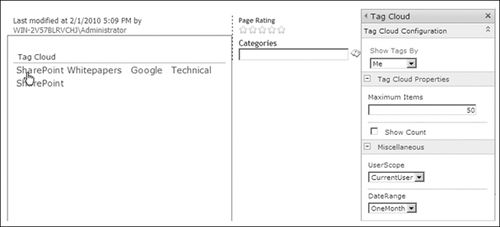9. Search Web Parts
The SharePoint 2010 Search
Results page is made up of many Web Parts that can be configured to
provide you with a customized search experience. The Web Parts discussed
in this section can be used to configure your search results page.
9.1. Advanced Search Box
The Advanced Search Box, shown in Figure 19,
provides users with the ability to search using more than just a text
box containing keywords. You can enter multiple search criteria using
the Advanced Search Box Web Part.
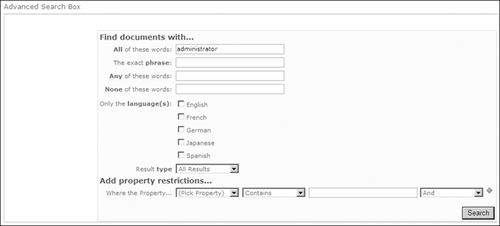
9.2. Dual Chinese Search
The Dual
Chinese Search Web Part allows users to select from either traditional
or simplified Chinese when entering search criteria. This Web Part can
also be configured to obtain this value from the browser.
9.3. Federated Results
The Federated Results Web Part displays Search results in a structured XML view, which can be styled using out-of-the-box
or custom XSLT. The location of the search results is set using the
options available on the tool pane, which include the following.
Internet Search Results
Internet Search Suggestions
Local Search Results
Local People Search Results
Local FAST Search Results
The tool pane shown Figure 20 displays the location property of the Federated Results Web Part commonly used on Search result pages.
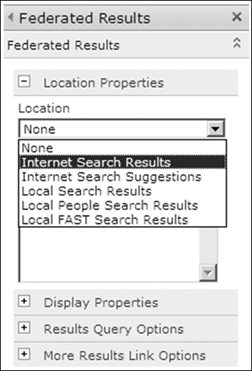
9.4. Refinement Panel
The Refinement
Panel Web Part enables searchers to minimize large results by
refinement of the results by type, site, author, or modified date. Using
the tool pane for this Web Part, you can modify the accuracy index by
choosing the top number of results to analyze in order to refine them.
9.5. Search Core Results
The Search
Core Results Web Part displays the results of your search. This Web
Part includes a number of settings you can apply, including location,
description, and scope within the location properties, along with
results sorting, number of characters to display in the summary of each
returned item, and the number of characters in each URL. Developers can
customize the XSLT of the Web Part to display the results in an
alternate way.
9.6. Related Queries
The Related Queries Web Part will display any related queries to the performed search.
9.7. Search Action Links
The Search
Action Links Web Part displays actions that the user might want to
perform on the returned results. The following actions can be displayed
or hidden using the tool pane.
Relevance View
Modified Date View
Search from Windows
Alert Me
RSS Link
9.8. Search Best Bets
Using the Search
Best Bets Web Part, administrators or content authors can create
keywords within SharePoint from the Site Settings page. These keywords
can be associated with a returned result and marked as the best bet
result for that particular search term.
9.9. Search Paging
The Search
Paging Web Part provides users with navigation between the result sets,
which by default will show 50 returned items at a time.
9.10. Search Statistics
The Search
Statistics Web Part displays the speed of a search. Other statistics
can be shown, such as the number of results shown on a page, total
number of results, search response time, and latency traces. The Search
Statistics tool pane is shown in Figure 21.
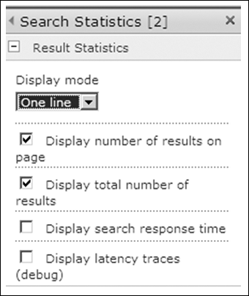
9.11. Top Federated Results
The Top Federated Results Web Part shows and highlights the top items (you specify the number) returned from a specified location.
10. Social Collaboration Web Parts
With the advent of social computing and collaboration comes the introduction of social collaboration Web Parts. There are six Web Parts in this category. The one that you are likely to use most often is the Tag Cloud Web Part.
Tagging, introduced in
SharePoint 2010, is an easy and natural way to provide navigation to
content. If the User Profile service and My Sites service is enabled,
users can tag documents, list items, lists, pages, sites, and external
content. Each tagged item can be selected to display within the Tag
Cloud Web Part. For example, when uploading a document to a SharePoint
2010 document library, users can enter their own metadata, which tags
the document, as shown in Figure 22.
The Tag option is displayed on the Ribbon that is displayed at the
upper right of every page, allowing you to tag the document and choose
when the tag will display.
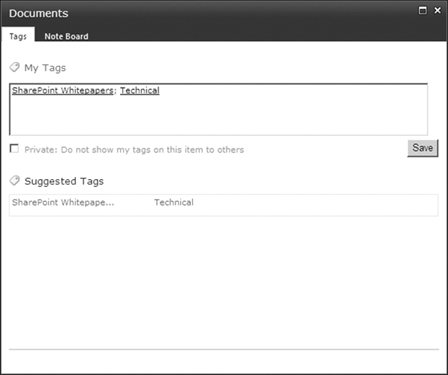
To tag external content,
click the Tagging icon at the upper right of your page. You will see a
link that says Right-Click Or Drag And Drop This Link To Your Browser’s
Favorites Or Bookmarks Toolbar To Tag External Sites. If you click the
Tagging icon when browsing external sites, the Tagging interface shown
in Figure 23 will open, allowing you to tag non-SharePoint websites and pages.
The tagging information
is stored within your SharePoint user profile, which you can visit and
manage by clicking the Welcome link and then selecting User Profile.
When users have been tagging content, it is useful to display the
results within the Tag Cloud Web Part, as shown in Figure 23.
